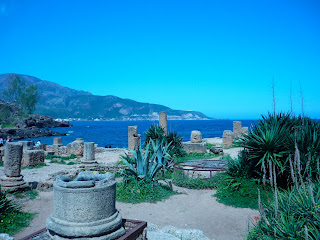Photos from Tipasa. Old rocks to some; Roman ruins to others.
Amphitheater.
main east-west street
main north-south street, north end ends at the Med.
Looking west toward the end of the old town. City wall is visible at the top of the hill to the north end of the ridge. Below it and a tad bit south is the site of the Byzantine church. The people in the picture are waiting to get picked up by little motor boats, which for a small price take folks on small tours of the bay. Bigger price, bigger tours.
No docks, just helping hands while one jumps to the rocks.
Mosaic floor.
What was once the courtyard of a wealthy homeowner's house.
Look closely, there are four pits that were used in making fish sauce, a Roman favorite. Whether or not it was garum or one of the other kinds I don't know. But four vats with fermenting anchovies, or whatever fish they used, must have added a nice ambient odor to the little town.
These four arches are reconstructed, at the large church on the hill.
"Downtown," from the church on the hill.
This is the nave, looking more or less east. The French used a lot of the stone for other construction projects during their tenure here. All the capitals sitting on the column bases I guess were just stacked there at some point. One of the policemen monitoring the site. Mostly they seemed to try to get the kids not to pose for the pictures on the edge of the cliff.
Steps up to the theater.
View from the top of the steps. All the little columns supported a wooden stage.
Amphitheater.
main east-west street
main north-south street, north end ends at the Med.
Looking west toward the end of the old town. City wall is visible at the top of the hill to the north end of the ridge. Below it and a tad bit south is the site of the Byzantine church. The people in the picture are waiting to get picked up by little motor boats, which for a small price take folks on small tours of the bay. Bigger price, bigger tours.
No docks, just helping hands while one jumps to the rocks.
Mosaic floor.
What was once the courtyard of a wealthy homeowner's house.
Look closely, there are four pits that were used in making fish sauce, a Roman favorite. Whether or not it was garum or one of the other kinds I don't know. But four vats with fermenting anchovies, or whatever fish they used, must have added a nice ambient odor to the little town.
These four arches are reconstructed, at the large church on the hill.
"Downtown," from the church on the hill.
This is the nave, looking more or less east. The French used a lot of the stone for other construction projects during their tenure here. All the capitals sitting on the column bases I guess were just stacked there at some point. One of the policemen monitoring the site. Mostly they seemed to try to get the kids not to pose for the pictures on the edge of the cliff.
Steps up to the theater.
View from the top of the steps. All the little columns supported a wooden stage.


















No comments:
Post a Comment